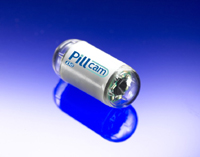|
Wireless Capsule Endoscopy
PillCam SB
The original capsule endoscope is the PillCam SB by Given Imaging. It is a disposable capsule, 11 by 26 mm in size and weighs 3.7g [6]. It is technologically possible to make a smaller capsule but the larger size keeps the device prevents the device from flipping over as it travels through the intestine. Each capsule contains size LEDs to illuminate the gasteroinstinal tract and CMOS optical detector to capture images. CMOS was selected over a CCD camera because the power consumption is lower. However, this comes at the expense of spatial resolution, an issue for diagnosis early stage disease. Located in front of the camera are a set of short focal length lenses that collect an image in a 140 degree field of view and magnify it by a factor of 8. An aperture changes the depth of view from 1 to 30 mm and creates clear images regardless location of the capsule. This optical system provides a resolution of 0.1mm.
The capsule communicates with the external world through a radio transmitter. Each second two pictures are transmitted at 432 MHz to an array of sensors taped to the patient’s abdomen. These sensors in turn relay information to a data recording device worn on a belt. Using more than one sensor makes it possible to triangulate the location of the capsule. This information is recorded as well to locate the location of abnormalities. The capsule is powered by two silver oxide batteries [1] [6].
 www.givenimaging.com www.givenimaging.com
PillCam ESO
A more recent development is the PillCam ESO, designed to increase the temporal resolution capsule endoscopy. In this device the capsule is the same size as the PillCam SB but contains two cameras and takes images at a rate of 14 per second. As a result, the battery life is significantly reduced. PillCam ESO is used to collect images in the esophagus where transit time is shorter than the lower digestive tract making faster sampling important.
 www.givenimaging.com www.givenimaging.com
Agile Patency System
Slightly over a year ago to FDA granted approval for a disposable capsule endoscope called the Agile Patency System. It is intended for use in patients with suspected intestinal obstructions. In most patients, this capsule will pass through the gastrointestinal tract just like the other capsules, but if it becomes stuck, its lactose body will be digested after 40 hours [1] [6].
 www.medgadget.com www.medgadget.com
|

